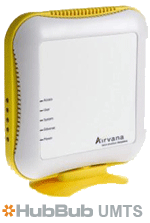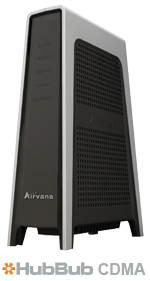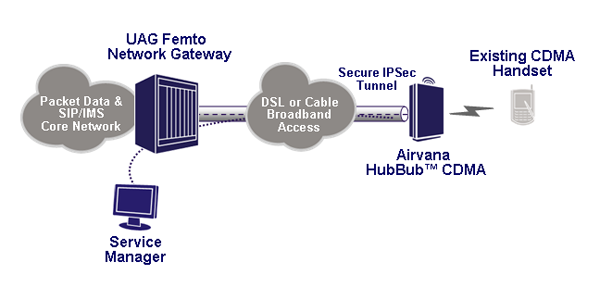 |About|News|Products|Prices|Solutions|Support|Registration|Services|Jobs|Contacts|Home|
|About|News|Products|Prices|Solutions|Support|Registration|Services|Jobs|Contacts|Home|

Airvana products for mobile industry (3G UMTS/CDMA2000) - femtocells

Matrix UAB presents to you Airvana exciting new products,
for 3G UMTS or CDMA2000 operators, the products that will change the
mobile industry for ever.
About Airvana
Airvana is a leading provider of network infrastructure products used
by wireless carriers to provide mobile broadband services.
Airvana’s products enable wireless networks to deliver
broadband-quality multimedia services to mobile phones, laptop
computers and other mobile devices. These services include Internet
access, e-mail, music downloads, video, IP-TV, gaming, push-to-talk and
voice-over-IP. Airvana’s solutions enable new services and
deliver carrier-grade mobility, scalability and reliability with
relatively low operating and capital costs.
Worldwide, Airvana’s mobile broadband systems are deployed on six
continents in 16 major networks by industry-leading service providers
who demand high standards of
carrier-class performance.
How Can the Mobile Phone Become the Only Phone?
Consumers continue to replace fixed line calling with mobile minutes
– and in the case of younger callers, mobile phones are
increasingly their only phones. In fact, callers under the age of 24
make up to four-fifths of their long distance calls on wireless
networks (see Figure 1). What stands in the way of making the mobile
phone the primary phone for the rest of the demographic? Fundamentally,
consumers want great voice quality, reliable service, and low prices.
But today’s mobile phone networks often provide poor indoor
coverage and expensive per-minute pricing. In fact, with the continued
progress in broadband VoIP offerings such as Vonage and Skype, wireless
operators are at a serious disadvantage in the home.
Femtocells




A new class of small “base stations” has emerged,
called femtocells (sometimes written as two words, i.e. “femto
cells”). These devices are the size of a DSL router or cable
modem and provide indoor wireless coverage to mobile phones using
existing broadband Internet connections (see Figure 2). They will be:
Low-cost – Femtocells will be offered as a consumer purchase through mobile operators.
User-installed – Like cable modems and DSL routers, femtocells
will be installed by consumers and activated through service providers.
Low-power – Femtocells will transmit at 10-100 milliwatts, similar to Wi-Fi access points.
Broadband-connected – Femtocells utilize Internet protocol (IP)
and flat base station architectures, and will connect to mobile
operator networks via a wired broadband Internet service such as DSL,
cable, or fiber optics.
Based on cellular network standards – Femtocell will be
purpose-built for existing UMTS and CDMA standards, as well as emerging
standards such as WiMAX, UMB, and LTE. Compatible with existing mobile
handsets – In each technology market, femtocells will support
existing handsets.
Deployed in operator-owned spectrum – Femtocells operate in
licensed spectrum owned by wireless operators, and may share the same
spectrum with the macro cell
network.
What Femtocells Deliver for Users
For end users, femtocells will solve a number of existing problems and enable new applications and services:
Increased indoor coverage – Most femtocells will cover a radius
of 50-200 meters. In most homes, this can provide “five
bars” of coverage throughout the household.
Higher performance data – Unlike macro cells that support
hundreds of users, femtocells will support 4-6 simultaneously active
users. As a result, femtocell-based EV-DO and HDSPA connections will
have less contention and deliver higher data rates per user than in the
macro cellular environment.
Improved multimedia experience – With higher performance data,
femtocells will deliver a better multimedia experience with music,
photos, and live video to laptops, smartphones, and feature phones.
Better quality voice – In addition to the obvious voice quality
gains attributed to better coverage, femtocells will enable support for
a new generation of higher rate voice codecs that leverage fewer users
per access point and the proximity of the handset to the femtocell.
Enhanced emergency services – Because femtocells will know their
location, emergency services will find it easier to locate callers
seeking emergency services.
Converged mobile VoIP services – By using VoIP technologies, many
femtocells will be able to connect existing fixed line phones as well
as mobile phones.
Operators Need Capacity and Coverage
With the increase in mobile usage, operators are forced to plan for
increased capacity and coverage. But they continue to wrestle with
several fundamental and on-going problems. Site acquisition is
expensive – Increasing existing macro cell densities can solve
some of these problems, but site acquisition is problematic and has
long been a major expense and stumbling block for operator build-outs.
Nearly 50% of the cost of constructing a macro cell network is the cost
of site acquisition. In Europe where the density of GSM sites is
already high, acquisition of additional sites is highly regulated. In
the US, many communities negotiate long and hard to control cell site
location and visual impact. Denser cells mean more backhaul –
Smaller cells such as micro cells and pico cells can improve coverage
and capacity, but deployment can be a political challenge. Instead of
large tower sites, access to utility poles and other common utility
structures must be secured and provided with power and network
backhaul. Resulting deployments can be uneven, require considerable
manpower to install, and need widespread and potentially expensive
backhaul facilities.
Indoor coverage is a stumbling block – In the GSM market,
operators transitioning to UMTS networks are discovering that indoor
coverage is more difficult to achieve with
current cell densities. UMTS typically operates at higher frequencies,
making it more difficult to penetrate building walls. In addition,
UMTS’ transition from low-speed SMS to
higher-speed multimedia increases the demand for consistent mobile
broadband coverage. Among CDMA operators, new applications such as
push-to-talk and the burgeoning growth of corporate laptop Internet
access require blanket coverage to be effective. Existing phones must
be supported – The widespread deployment of Wi-Fi access points
has spurred the development of Wi-Fi fixed mobile convergence (FMC)
solutions – technology that allows dual-mode phones with both
Wi-Fi and cellular radios to access mobile operator networks. But these
early FMC solutions will not support existing cellular handsets in
either UMTS or CDMA markets.
Femtocell Benefits for Operators
Many of the challenges facing mobile operators can be addressed by
femtocells. As the technology rolls out, carriers stand to reap
significant benefits from femtocell deployment (see Table 1).
Increased network capacity – With customers installing
femtocells, operators will relieve stress on macro cell networks and
increase the overall capacity of mobile operator
networks. Each femto represents up to 4-6 calls offloaded from the macro cell radio network for roughly a third of each day.
Lower capital costs – Even as the number of subscribers in a
mobile operator’s network increases, the introduction of
femtocells will reduce the capital spent per user on new macro cell
equipment.
Expanded revenue opportunities – With excellent coverage and
superior broadband wireless performance, mobile multimedia services
will increase in popularity, raising
average revenue per user (ARPU).
Lower backhaul costs – The cost of backhauling traffic to the
operator’s core network will be handled by the user via DSL,
cable, or fiber access lines without any cost to the
operator.
Increased customer stickiness and conversion – With excellent
in-home coverage and home zone calling plans, operators will reduce
customer churn and attract more users to their family plans.
Hybrid Mobile Networks Emerge
The combination of femtocells and wired IP broadband will yield a new
generation of wireless network – the hybrid mobile network.
Previously, macro cell networks were owned and operated end-to-end by
mobile operators. As private networks, they were inherently secured by
the operating practices, equipment, and leased line services.
Hybrid mobile operator networks, on the other hand, will utilize a
combination of network transport services, some owned and controlled by
the operator, and some not. As
femtocells are deployed, operators will re-use large scale elements of
their current core networks such as billing, authentication,
authorization, accounting (AAA), policy, and
mobility services. But the use of the Internet as a backhaul network
will cause a fundamental architectural change for mobile operators.
Because femtocells will use any residential IP broadband connection,
customers will be plugging femtocells into the Internet via cable
modems and DSL routers. This will put increased emphasis on another
category of products – security and mobility gateways – to
protect the integrity of operators’ core networks from the public
environment of the Internet, to protect the integrity of users’
traffic, and to support seamless transitions between the macro and
femtocell networks.
To meet that need, a new generation of high-performance security and
mobility gateways has emerged. Designed to handle very large numbers of
encrypted tunnels and to manage handoffs between macro cell and Wi-Fi
networks, such gateways will become critical anchor points for the
security of femtocells and a fundamental element in future mobile
networks (see Figure 3).
Femtocell Enablers
Why have femtocells suddenly become a viable element in the evolution
of mobile networks? Three market and technology advances have led to
this shift.
Widespread wired broadband – Widespread availability of DSL,
cable, and fiber optic broadband have opened the door for femtocell
deployment scenarios. Because customers are already utilizing broadband
Internet, femtocells can be deployed anywhere there is a residential
broadband IP service.
Low-cost processors – The recent availability of low-cost,
powerful field programmable gate arrays (FPGAs) and digital signal
processors (DSPs) has allowed complex base station software to be run
on very small platforms. FPGAs have traditionally been the basis of
high-end network equipment with parts costing upwards of a $1,000 each,
but prices have been on a steep decline. According to the FPGA Journal,
FPGA costs per 1000 gates fell by 97% between 1998 and 2005. In
addition, FGPAs now offer the option of conversion to even lower-cost
application-specific integrated circuits (ASICs).
Flat architectures – Because powerful processing can be applied
to low-cost femtocells, network software stacks can be substantially
collapsed. In addition, the standard Internet protocol (IP) has rapidly
replaced hierarchic telecom-specific transmission protocols. The
combination of collapsed software stacks and IP transport enable
femtocells to utilize flat networks – such as the Internet
– as a backhaul transport to operator core networks (see Figure
4).
Technical Hurdles for Femtocells
Though the technology has advanced quickly, a number of challenges
still need to be addressed to make femtocells successful as high-volume
products. Because each
represents an area of innovation, many will become significant aspects
of competition and differentiation among femto access point suppliers.
Radio interference mitigation – Unlike macro cellular
installations where the RF coverage can be manually tuned and optimized
by technicians over a long period of time, femtocells will need to
sense the radio environment around them from the moment they are
plugged in by the consumer. Femtocells will then need to mitigate
potential interference by dynamically adjusting for two typical
scenarios.
· Macro-femto interference. Though they are statically
configured, macro cell RF densities and through-wall penetration will
be unpredictable and will vary depending on
where a femtocell is installed. Though operators will understand the
general RF footprint of their macro cell deployments, they will have no
control over where their end
customers will deploy femtocells. The femtocells must adjust themselves to avoid interference in macro cell networks.
· Femto-femto interference. As many consumers install their own
femtocells, the RF environment will become more complex. Femtocells
will begin to impact other
femtocells, particularly in urban multi-tenant environments but also in
some densely packed suburban situations. When a neighbor installs a new
femtocell, other femtocells must adjust their transmissions to control
interference.
In both scenarios, mobile operators will need the ability to see what
femtocells see – or hear what femtocells hear – in the RF
domain. This will be true both for installation and ongoing maintenance
of femtocells.
Automatic system selection – When an authorized user of a
femtocell moves in or out of the coverage of the femtocell – and
is not on an active call – the handset must correctly select the
system to operate on. In particular, when a user moves from the macro
cell into femtocell coverage, the handset must automatically select the
femtocell, and visa versa. Since some operators will be offering
special home-zone pricing when a subscriber is connecting through a
femtocell, an indication is also needed on the handset to inform the
subscriber of the network it is operating on.
Active macro-femto handoffs – When an authorized user of a
femtocell moves in or out of coverage of the femtocell – and is
on an active call – the handset must correctly hand off between
the macro cell and femtocell networks. Such handoffs are especially
critical when a user loses the coverage of a network that is currently
serving it, as in the case of a user leaving the house where a
femtocell is located.
Security – Because femtocells will connect back to an
operator’s network via the public Internet, each femtocell
establishes an encrypted tunnel into the network using industry
standard IPsec technology. A femtocell must identify and authenticate
itself to the operator’s network as being valid – so a
hacker cannot spoof the network into thinking his femtocell is someone
else’s and fraudulently use another customer’s services.
Scalability – Security and scalability are interdependent
problems. Because each femtocell must be secured using IPsec, each
could represent at least one or more IPsec
tunnels. With millions of femtocells deployed in a network, operators
will require large scale security gateways at the edge of their core
networks to handle millions of femtocelloriginated IPsec tunnels. In
addition to aggregating large numbers of tunnels, femto security
gateways will be required to protect the operator’s network from
Internet generated attacks such as man-in-the-middle and denial of
service attacks.
Access control – Consumers and operators will require a range of
access control mechanisms. Since femtocells use the broadband Internet
connection owned by the user
for backhaul, consumers should be given the option to control the use
of their femtocells. In particular, a femtocell owner should be allowed
to easily add and delete authorized users and to exclude unauthorized
users near the femtocell, such as a stranger walking by or a neighbor
in a multi-tenant building.
Activation & management – This area may determine the success
or failure of many products and services. Since most femtocell products
will be purchased in a way similar to mobile phones, ease of customer
installation and activation is paramount. The endcustomer must be able
to open the box, power up and plug the femtocell into the network, call
a number for activation, and have a one-touch means of registering
handsets. In addition, operators must have management systems that give
first-level support technicians full visibility into the operation of
the femtocell and its surrounding RF environment.
Future Considerations & Impact
The emergence of femtocells and hybrid mobile networks will likely lead
to structural changes in 3G networks and to potential disruption in the
operator market.
Missing the Train
Some mobile operators may only watch as their competitors deploy
millions of femtocells. As a result, they will be left with an
expensive radio infrastructure, high priced telecom backhaul, and the
shared-bandwidth multimedia experience of macro cellular environments.
These operators will be at a fundamental disadvantage in terms of
network cost, breadth of services, and end-user experience –
disadvantages that will rapidly erode their competitiveness and
profitability.
Content Focal Point
Although femtocells will start with the humble task of providing voice
and data services to the handset, they could deliver other services and
become the focal point of user content. Femtocells could become the
means by which consumers access all the music, video, and photos that
reside in their home – via the mobile network. Because femtocells
can provide an improved broadband experience, mobile devices may become
the preferred devices for multimedia. With a faster and more responsive
femtocell network, mobile devices may expand their functionality, and
become the vehicle for creating, managing, storing, and publishing
mobile multimedia content.
Vehicle for 4G Deployment
Femtocells may be an ideal way to introduce the next generation of
mobile networks – 4G technologies such as WiMAX, UMB, and LTE.
Instead of incurring the enormous expense of upgrading the entire macro
cell infrastructure to 4G, mobile operators may choose to introduce
islands of 4G in an ocean of 3G. In fact, femtocells may prolong the
life of the 3G macro cellular. In addition, femtocells may also be a
lower risk technology platform for the introduction of 4G, since the
cells are smaller, the numbers of users per cell is significantly less
than a macro cell environment, and the higher speed backhaul required
for wireless operating at greater than 100 Mbps will be readily
available.
Conclusion
Femtocells will change the mobile industry. Operators will use
femtocells to build a new generation of lower cost, flat architecture
networks that can utilize the Internet as backhaul and deliver expanded
capacity for customers. This hybrid mobile network will yield an
improved platform for new mobile multimedia services, higher revenue,
and new technology introduction. Femtocells will also change the mobile
broadband experience for customers. Excellent wireless coverage in the
home will become the norm and not the exception. Femtocells will raise
the bar for high performance broadband wireless and customers will
expand the utility of mobile broadband devices.
If you think about the future, and have project with Airvana networking products, please ask for solution sales@matrix.lt .
Revised: November 10, 2008, Copyright MATRIX, UAB


![]() |About|News|Products|Prices|Solutions|Support|Registration|Services|Jobs|Contacts|Home|
|About|News|Products|Prices|Solutions|Support|Registration|Services|Jobs|Contacts|Home|






